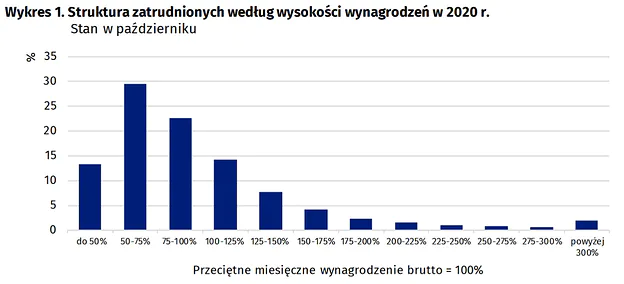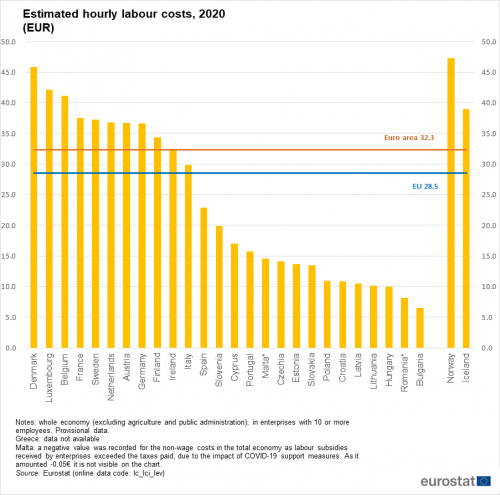Poland’s median monthly wage stood at 4,703 zloty (€1,000) before tax in October last year, according to new data released by Statistics Poland (GUS), a government agency. That is 15% higher than the previous calculation of 4,095 zloty in 2018 and 62% up from a decade ago.
The data, which are released by GUS every two years, differ significantly from the much more commonly cited mean wage in Poland, which in October 2020 stood at 5,748 zloty (22% higher than the median).
A higher mean (which is the sum of all salaries divided by the number of them) than median (which shows the midpoint of all salaries) suggests that there are some people at the higher end of the scale earning significantly more than the overall group and thus inflating the mean figure.

Structure of earnings relative to the mean salary, October 2020. Source: GUS
GUS’s October 2020 data show that 69% of women and 63% of men received salaries equal to or lower than the mean. Men’s salaries were on average 14.7% higher than those of women. The minimum wage at the time, 2,600 zloty, was earned by 7.8% of workers.
Over the last decade, the mean salary has always been between 22% and 25% higher than the median. The figures are based on wages paid by companies and institutions employing more than nine people.
The most recent data, released by GUS last week, show that the mean monthly wage has reached 5,917 (€1,258) zloty.
According to GUS, the average hourly wage increased by almost 20% between October 2018 and 2020, reaching 33.24 zloty (€7.04). The average hourly rate for men was 13.6% higher than that for women.
Compared with the rest of the European Union, Poland continues to have some of the lowest hourly costs of labour (which also include non-wage costs, such as social contributions payable by the employer).
In 2020, average hourly labour costs were estimated at €11.0 in Poland compared to €28.5 across the EU as a whole. The lowest figures were in Bulgaria (€6.5) and Romania (€8.1) and the highest in Denmark (€45.8) and Luxembourg (€42.1).

Estimated hourly labour costs, 2020. Source: Eurostat
Main image credit: Yolk CoWorking – Krakow/Unsplash

Maria Wilczek is deputy editor of Notes from Poland. She is a regular writer for The Times, The Economist and Al Jazeera English, and has also featured in Foreign Policy, Politico Europe, The Spectator and Gazeta Wyborcza.




















